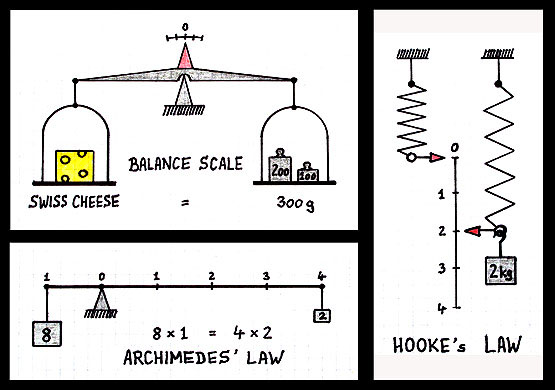previous <<==>> next
THEORY - HOW MECHANICAL SCALES WORK ...

FIG.1 Balance Scale
-------------------
Many pharmacies proudly display an historic PRECISION BALANCE SCALE
made out of shiny brass inside a crafted glass cover. Also today
"robust" steel versions are to find in farmer's markets: The PIECE
OF CHEESE (eg.) on the left side is compared with CALIBRATED WEIGHTS
on the right until the scale is in balance. The sum of all weights
on the right side equals the weight of the cheese on the left side -
and this makes the price.
Fig.2 Archimedes' Law
---------------------
The historic pharmacy scale has equal levers (= "Arms") on both sides.
But this is not necessary according to ARCHIMEDES' LAW. German pupils
learn it in its simplest form ... "Kraft x KraftArm = Last x LastArm".
In English ...
» Force times Force-Arm-Length equals Weight times Weight-Arm-Length «
Common LETTER SCALES (eg.) uses this principle: A variable Weight-Arm.
Most KITCHEN SCALES are made, using this equation: Lever arrangements
connect the bowl on top with shiftable weights on a calibrated arm ...
Preparation & WEIGHING PROCEDURE:
o Set all WEIGHTS to ZERO.
o Make sure the BOWL is empty.
o Shift the ZERO-ADJUST WEIGHT until the scale is in balance.
( This allows to use other carriers than the bowl !)
o Place (eg.) the piece of SWISS CHEESE in the bowl.
o Shift the big & small weights until the scale is in balance.
o READ the POSITION of the WEIGHTS on the calibrated arm ...
(eg.) 300 g + 20 g = 320 g
Fig.3 Hooke's Law
-----------------
The most common type of a mechanical PERSON SCALES in bathrooms work
on a SPRING according to HOOKE's LAW: It stated that ...
» The stretch of a spring is proportional to the force applied «
With gears the spring's movement is readable on a calibrated dial.
Start with a TOY BALANCE SCALE ...
impressum:
**********************************************************************
© C.HAMANN http://public.BHT-Berlin.de/hamann 01/12/12
|